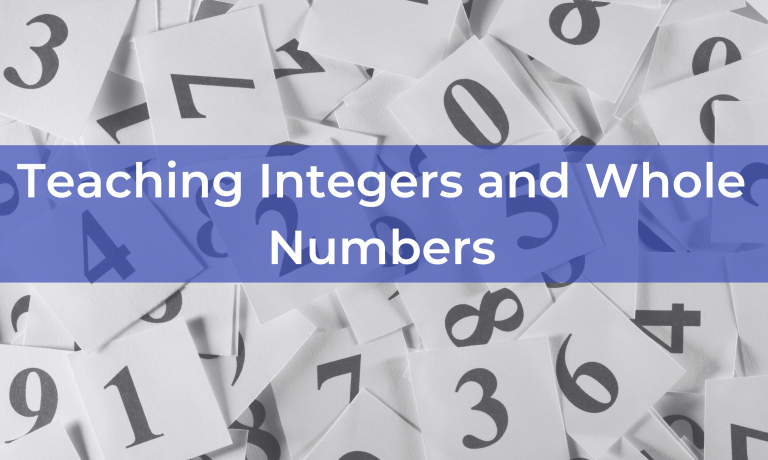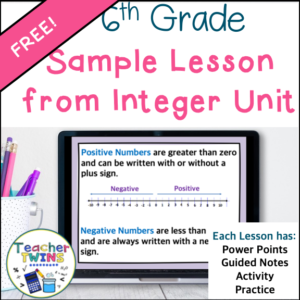Learning the meaning of integers and whole numbers is an important concept in middle school. Most students recognize that there are situations where negative numbers are used (football, money, golf and finding temperatures). Even though they may be familiar with negative numbers most students do not really know what integers are.
What are Integers and Whole Numbers?
Definitions
Here are the definitions for integers and whole numbers:
Whole Number– a set of numbers including all positive integers and 0. { 0, 1, 2, 3, 4 . . .}
Integer– whole numbers and their opposites. {. . .-2, -1, 0, 1, 2 . . .}
Based on the definitions an integer is:
- a positive whole number
- a negative whole number
- zero
An integer is not:
- a fraction when it is in its simplest form
- a mixed number when it is in its simplest form
- a decimal number

A lot of students believe that an integer is any number with a negative sign in front of it. Looking at the definitions we see that whole numbers which are positive, are also integers. Numbers that are decimals or have fractional parts are not integers, even if they are negative.
What are Opposites?
The opposite of any number(also called the additive inverse) is the number that is the same distance away from zero on a number line, but it is in the opposite direction (which means it will have the opposite sign).
Example: 6 and -6

By definition integers are whole numbers and their opposites. If you look at the number line above you see the whole number 6 and its opposite -6. You can classify these numbers as follows:
6 whole number and integer
-6 integer
Both of these numbers are the same distance away from zero on a number line so they are opposites.
Teaching Integers and Whole Numbers
Now that we have reviewed the definitions of an integer and whole number, let’s think about how we can teach this concept to students.
To introduce the concept of integers, I engage students in a discussion about integers and whole numbers. As we have the discussion I ask leading questions based on their responses. I want students to explain their reasoning to their classmates. I do not tell them if their answers are correct or incorrect.
Step One- Defining Whole Numbers
Put a whole number on the board and ask students if it is a whole number? The students defend their answers about why the number is a whole number or why it is not. You can have the students answer in pairs first and then share with the class or you could have a class discussion. Put several more numbers on the board (include negative as well as positive numbers and include positive and negative fractions and decimals) and ask them if they are whole numbers. After you have been discussing for a while, ask the students to define a whole number. Write the responses that they give on the board. Using the information provided from the students, define whole numbers.
Step Two- Defining Integers
Put a number on the board and ask students if the number is an integer? Continue with the discussion having the students defend their answers. Next, give students a set of numbers that are not integers and a set that are integers. Make sure to include several numbers, including positive and negative fractions and decimals. Using these sets, have the students tell what an integer is. This part of the lesson usually takes longer because the students are typically not as knowledgeable about integers. Once our discussion has ended, I ask them to define an integer. Record their ideas on the board. Using the information provided from the students, define an integer.
Step Three- Identifying Integers and Whole Numbers
Using the information provided from the students we use our definitions of integers and whole numbers to identify numbers. Put a list of different numbers on the board and have the students classify them as whole numbers, integers or neither. They must use the definitions to justify their classification.
Conclusion
The knowledge of the difference between a whole number and an integer is very important. Middle school students need to understand these concepts to be successful in higher math classes. I have provided a FREE Integer lesson below if you would like to use it to help you teach integers to your students. The lesson has a Power Point on Integers, guided notes to follow the Power Point, a dominos activity and a practice sheet.



